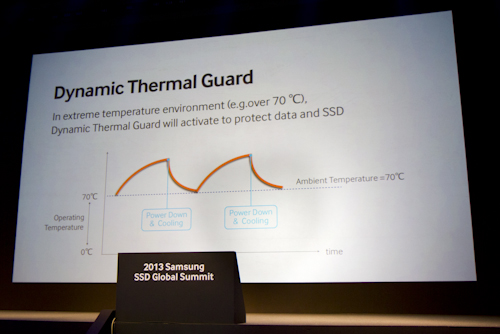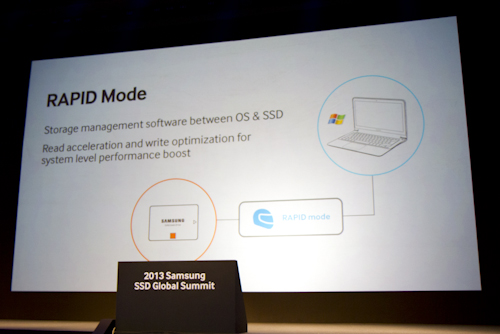Samsung's SSD Global Summit: The Leader In NAND Speaks Up
The theme of this year's Samsung SSD Global Summit, in Seoul, Korea, was SSDs For Everyone. More than 100 journalists from around the world showed up for this one-of-a-kind event, where we got a taste of the future in solid-state storage.
Advancements Beyond NAND, Continued
While Turbo Write is a feature that you can almost always take advantage of, Dynamic Thermal Guard is something that you hope to never use. Almost every SSD not specified for industrial applications has an operating range between 0 and 70 degrees Celsius. High temperatures can cause a number of issues with NAND, from lower write endurance to bit errors.
So, when Dynamic Thermal Guard picks up temperatures in excess of 70 degrees, it cuts back on write performance to reduce power consumption and, consequently, heat until the drive falls back into a safer thermal range. SSDs certainly aren't indestructible. They consume power, dissipate heat, and typically require airflow over their enclosures. This feature should help safeguard an SSD's sensitive components, even if the other parts in your PC are aggressively overclocked.
Finally, Samsung showed of the spoils of its 2012 acquisition of data caching company Nvelo. It's RAPID software-based feature allows the Samsung's SSDs to cache hot data in host memory to accelerate I/O. The performance improvements it showed off on-stage (and we later demonstrated on this page of our 840 EVO review) were outstanding.
The demo we saw in Seoul had read performance jump over 750 MB/s, while writes more than doubled to 1100 MB/s. Even though Windows already caches writes, RAPID takes this to another level entirely. It does come at a cost, though. RAPID uses up to 1 GB of host memory, though that number is dynamic and depends on the amount of RAM available. When asked about the possibility of power loss, David Lin, vice president of product management for RAPID, conceded that data could be compromised. He then tempered our concern somewhat by adding that RAPID responds to operating system flush commands, which are issued regularly.
RAPID is currently only enabled in Windows, but will be available for all 840-series drives once Samsung's Magician 4.2 software is released.
We're glad to see Samsung investing heavily in innovative ways to boost storage performance, and not just relying on its most obvious advantages over other companies. It's latest features aren't necessarily exclusive; however, when you combine them with a proprietary controller, the company's own flash, and planned firmware updates, it's clear to see that Samsung isn't resting on its laurels.
Get Tom's Hardware's best news and in-depth reviews, straight to your inbox.
Current page: Advancements Beyond NAND, Continued
Prev Page Advancements Beyond NAND Next Page An Editorial On Write Endurance-
ojas Well, i have 2.3 TB of writes and 4.36 TB of reads on my 120GB Intel 320 series SSD in the last year...no re-allocated sectors thus far.Reply
My 840 has about 0.41TB written to it, and i bought this drive a few months ago.
Anyway, looking forward to RAPID. -
Someone Somewhere @radiovan I read it as being that it's a replacement for AHCI/IDE - it'll still work with SATA.Reply
Anyone else find that this reads like an infomercial? -
Steveymoo Ahh Samsung, you're still not immune to the age old marketting technique of combining large breasted women with your technology, to catch men's eyes.Reply -
Onus Organizations with huge amounts of data to sift (e.g. Google, NSA, IRS) will want any speed they can get. Labs doing FCAT testing need ridiculous write speeds. For the rest of us, as individuals, if a bloated application like Word already loads in the blink of an eye, any faster simply doesn't matter. I hope a substantial focus can be placed on cost.Reply -
JPNpower CPUs GPUs are sort of slowing. this is the future. This is innovation at its hottest and fastest. Maybe it is competition as some say, as AMD is bogged down in processors, giving the leaders a healthy lead, but in flash, Samsung, Sandisk/Toshiba, and Micron are hot at it.Reply
Everyone wins. -
jabliese radiovan and SomeoneReply
NVMe is a protocol to work with PCIe. This is quite clear from the slides. What is PCIe? Do you remember your last video card upgrade? The slot your card plugged into was most likely a PCIe slot. NVMe has no business with SATA, and that's the way you want it to be. -
drewriley Reply11318974 said:No word on when we might be seeing the new vertical NAND in products?
Last year, Samsung touched on some new technologies that they were working on, but didn't share any insight during their latest summit,


